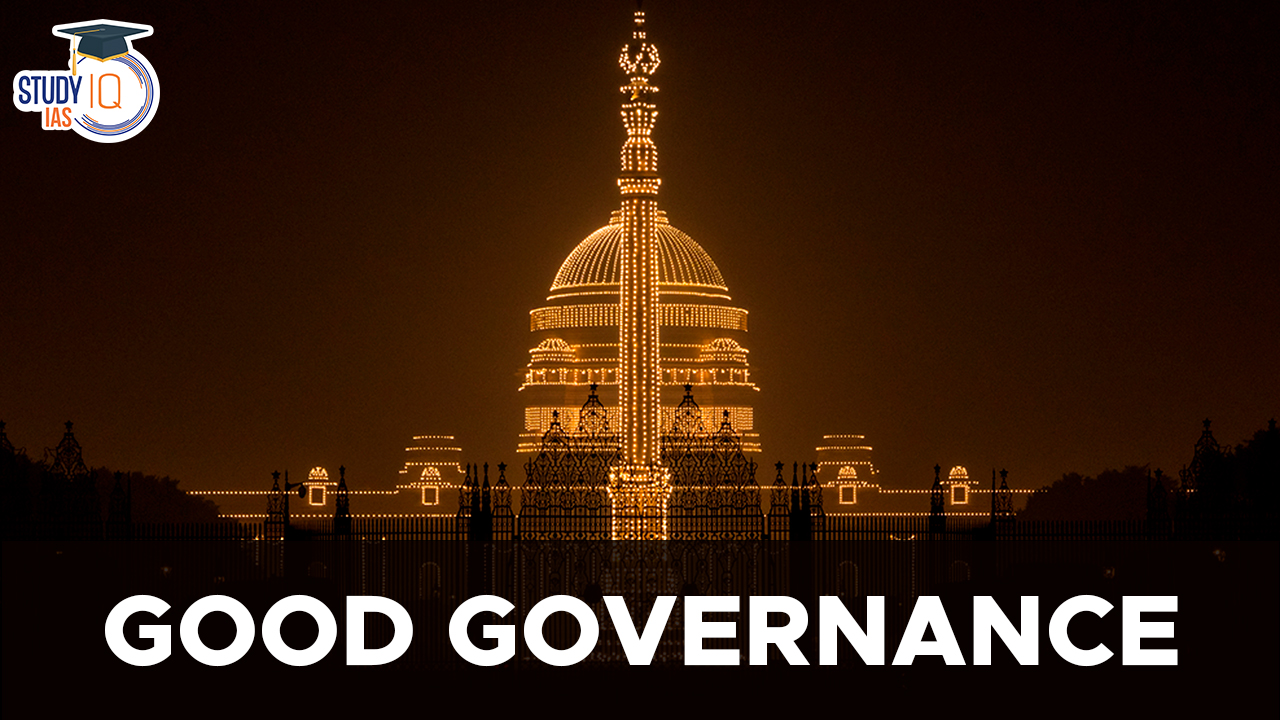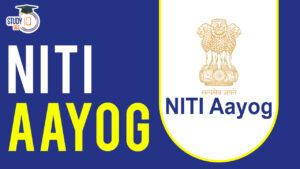Table of Contents
Good Governance
The administration of public affairs in a just, fair, and reasonable manner is good governance. Federal countries like India have different administrative systems, which can complicate governance and influence the idea of good governance. To evaluate how well state and union territory administrations are doing, the Indian government created the Good Governance Index.
Good Governance is an important part of Indian Polity which is an important subject in the UPSC Syllabus. Students can also go for the UPSC Mock Test to get more accuracy in their preparations.
We’re now on WhatsApp. Click to Join
What is Good Governance?
A government is a group of people who manage a country’s administration, representing the state’s interests. Different types of government, like democracy and autocracy, serve the same purpose to govern. Governance refers to the rules and laws set by the government that officials must follow. The term “governance” dates back to the 14th century in France and comes from the Greek word “Kybernan,” meaning “to steer.” Harland Cleveland introduced the term in 1972.
The World Bank defines governance as how power is used to distribute resources, while the UNDP sees it as the authority to manage a nation’s affairs, emphasizing transparency and accountability. Professor Kuldeep Mathur highlights that governance involves changes in how the state interacts with the private sector and civil society.
Good Governance Day
Good Governance Day is celebrated in India on December 25th, which coincides with the birth anniversary of former Prime Minister Atal Bihari Vajpayee. It’s a day dedicated to promoting transparency, accountability, and responsiveness in government, aiming to enhance public trust and improve the lives of citizens.
Good Governance Eight Principle
The UN has identified eight important components of successful government. Here is a summary of what each of them is all about:
| Good Governance Eight Principle |
ResponsiveInstitutions and procedures must provide timely service to all stakeholders. AccountableThe goal of good governance is to make people’s lives better, but this cannot happen until public and institutional stakeholders keep governmental institutions, commercial sectors, and civil society organisations accountable. TransparentInformation regarding how the government operates should be accessible to the general people . Effective and EfficientGood governance entails that organizations and procedures produce outcomes that satisfy societal needs while making the best possible use of available resources. This includes preserving the environment and making sustainable use of natural resources. Equity and InclusivenessA just society is ensured by effective governance. In a society like this, nobody or any group feels excluded or marginalized. No one should be discriminated against, and opportunities should be provided to everyone regardless of their backgrounds. Consensus-orientedMaking decisions ensures that even if no one gets all they want, everyone can still achieve a common minimum that is beneficial to everyone. ParticipatoryMen and women should be able to express themselves through legitimate local organizations or representatives, as well as underrepresented groups in society, such as minorities, the working class, and others. Rule of LawThe legal system, in particular the human rights rules, ought to be applied fairly. If there is no rule of law, the powerful will prevail over the weak. |
Good Governance Need
There is a need for good governance since it promotes political, social, and economic development. Let us examine how good governance advances each of these three areas in more depth:
| Good Governance Need |
Economic DevelopmentAn unsteady administration makes it difficult for a state to advance economically. Among the difficulties faced by economic development are those related to producing, distributing, investing, and even consuming. However, good governance and equitable resource allocation within the state will make it simple to remove these obstacles. Social Development and Good GovernancePeople from different religions, social classes, and castes live together peacefully in societies. However, if income isn’t shared fairly, it can lead to problems. Even when income is unevenly distributed, it is important to ensure that minorities feel safe and supported. To address these issues, we need to adopt various reforms to help close the gender gap in society. Political DevelopmentThe effectiveness of having good governance for society depends on politicians’ honesty and obedience to the laws and rules of the system. The government and political parties must develop policies for the welfare of the people and cooperate effectively to ensure healthy competition. |
Characteristics of Good Governance
Good governance encompasses a diverse set of principles and practices that contribute to a well-functioning society. Here are some key characteristics that define it:
- Citizen engagement: Active involvement of citizens in decision-making processes through voting, consultations, and feedback mechanisms.
- Inclusiveness: Ensuring everyone has the opportunity to participate regardless of background, ethnicity, gender, or socio-economic status.
- Freedom of expression: Guarantee of open and respectful dialogue, where diverse viewpoints can be heard and considered.
- Fair and impartial legal system: Consistent application of laws without bias or favoritism.
- Accountability of government: Holding public officials responsible for their actions and decisions.
- Access to justice: Ensuring everyone has equal access to legal services and the justice system
- Openness and accessibility of information: Public accessibility to government data, plans, and decisions.
- Corruption-free practices: Strong systems to prevent and combat corruption within the government.
- Regular reporting and communication: Proactive engagement with citizens through clear and understandable communication.
- Listening to citizens’ needs and concerns: Prompt and effective response to public feedback and requests.
- Delivery of quality services: Efficient and effective provision of essential public services, such as healthcare, education, and infrastructure.
- Adaptability to changing needs: Flexibility to adjust policies and programs in response to evolving circumstances.
- Fair distribution of resources and opportunities: Addressing imbalances and ensuring everyone has a chance to thrive.
- Non-discrimination: Protection against discrimination based on any factor, such as race, religion, gender, or disability.
- Focus on disadvantaged groups: Special attention to the needs and vulnerabilities of marginalized communities.
- Achieving desired outcomes: Using resources wisely and achieving set goals for policies and programs.
- Minimizing waste and inefficiency: Eliminating unnecessary bureaucracy and maximizing the impact of available resources.
- Continuous improvement: A commitment to ongoing evaluation and refinement of governance practices.
Associated Challenges with Good Governance
There are many challenges associated with good governance in India, A few are mentioned here:
Criminalization of Politics
A total of 43% of Lok Sabha MPs were facing criminal charges in 2019, according to figures provided by the Association of Democratic Reforms. Since 2014, this figure has climbed from 26%. Public policy and governance are badly impacted by the criminalization of politics and the unjust alliance of elected officials, government employees, and corporate entities. As a result of this growing criminalization of politics, the public has begun to see the political class with less respect.
Corruption in Good Governance
For a very long time, India’s governing structure has been plagued by corruption. It significantly impedes quality and good governance. Although individual greed undoubtedly contributes to corrupt practises, other factors such as a weak enforcement system and structural incentives also contribute to the growth of corruption in India. India has achieved the rank of 80th in the 2019 corruption perception index.
Increasing Violence
The proper implementation of law, order, and peace in the public sphere is essential for good governance. Increased rates of crime and violence in society are indicators of poor governance.
Gender Discrimination
The traditional Indian culture has long been characterised by gender inequality, where women are devalued in comparison to men. The situation and position of women in a state might be used to assess its condition. The ideal male to female ratio is 50:50, although this is unbalanced in almost all of the states. Additionally, as a result of this, women’s participation in politics and other related fields is insufficient in comparison to men.
Delayed Justice
The delivery of prompt justice to the public is impeded by practises including criminalization and political corruption. This causes the proceedings to drag on for months or even years, delaying the victims’ access to justice.
Centralization of Administrative System
Only if lower-level governments are given sufficient authority and power through the decentralization process will they be able to perform at their best. The centralization of the administrative structure particularly affects Panchayati Raj Institutions, whose constitutionally mandated duties are not carried out due to limited funds and personnel.
Marginalization of Backward Classes
The economically and socially disadvantaged sector of society has been disenfranchised ever since India’s independence. Despite the provisions made by the constitution for the advancement of socially and economically disadvantaged groups, they continue to lag behind in a number of crucial areas, such as economics, education, and other fields.
Government Initiative for Good Governance
There are numerous government initiatives across the country aimed at promoting good governance. Here are some notable examples given below:
RTI (Right to information)
Under Article 19 of the International Covenant on Civil and Political Rights, India is required to uphold the right to information for all of its inhabitants. The introduction of the RTI in the nation strengthens democracy. All of the nation’s population having access to knowledge about government activities encourages the government to act responsibly and favourably. Access to written information encourages government accountability.
E-Governance and Good Governance
The government aims to be transparent, reliable, and efficient so that everyone in the country can access its services. New information and communication technologies are improving e-governance, making it easier to offer better programs and services. E-governance helps citizens by making it simpler for them to use government services online.
Good Governance for Ease of Doing Business
The government has started the innovative Make in India program to encourage conducting business in India. By passing legislation aimed at enhancing the business environment, the government has also enhanced the policy ecosystems.
Legal Reforms
By removing roughly 1500 revised rules and regulations, it seeks to increase efficiency and promote openness. Criminal justice and procedural reforms must put a premium on mediation before incarceration.
Good Governance Index (GGI)
The Good Governance Index (GGI) is a useful tool that helps compare how well different States and Union Territories (UTs) are governed. Its goal is to provide a fair way to measure the success of various projects started by the Central and State Governments, including UTs. Launched in 2019 by the Department of Administrative Reforms and Public Grievances (DARPG) in India, the GGI uses 58 indicators from ten sectors, such as agriculture, business, human resources, and public health. This index encourages friendly competition among States to improve their governance.
Initiatives for Good Governance in India
To improve governance, India has implemented several measures, including:
- 73rd and 74th constitutional amendments for democratic decentralization
- The Right to Information Act, 2005
- Citizen’s Charters and Social Audits
- E-Governance and ICT tools
- Aspirational District Program to reduce regional disparities
- The Insolvency and Bankruptcy Code, 2016
- Consolidation of labor laws
- The Sevottam Model for service delivery
- The Centralized Public Grievance Redress and Monitoring System (CPGRAMS)
Conclusion
As India develops, it is important to focus on Gandhian principles like “Antodaya” to improve governance. Efficient and accountable governance can lead to better living standards and increased per capita income for citizens.
Good Governance UPSC
Every person in the nation is interested in seeing the government-run as efficiently as possible. Citizens are willing to pay more for efficient government services, but what is required is a fair, impartial, transparent, and clear system of governance. We must restructure our national strategy to give the Gandhian principle of “Antyodaya” top priority in order to restore efficient governance to the nation. India should endeavour to improve government integrity, which will make it more moral. In order to promote inclusive and sustainable growth, the government should continue to emphasise the Sabka Saath, and Sabka Vikas ideals. Students can read all the details related to UPSC by visiting the official website of StudyIQ UPSC Online Coaching.


 Indian Councils Act 1861, History, Provi...
Indian Councils Act 1861, History, Provi...
 NITI Aayog Report on India’s Hand and ...
NITI Aayog Report on India’s Hand and ...
 9th Schedule of Indian Constitution: His...
9th Schedule of Indian Constitution: His...





















